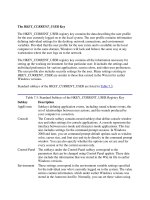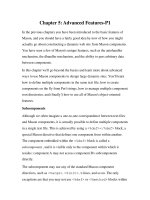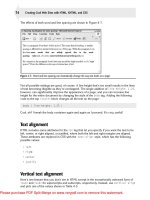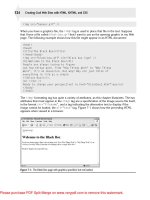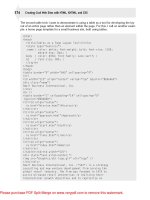Tài liệu The Counterterror Coalitions - Cooperation with Europe, NATO, and the European Union doc
Bạn đang xem bản rút gọn của tài liệu. Xem và tải ngay bản đầy đủ của tài liệu tại đây (642.5 KB, 82 trang )
Cooperation with Europe, NATO,
and the European Union
THE COUNTERTERROR COALITIONS
Nora Bensahel
Project AIR FORCE
R
Prepared for the United States Air Force
Approved for public release; distribution unlimited
RAND is a nonprofit institution that helps improve policy and
decisionmaking through research and analysis. RAND
®
is a
registered trademark. RAND’s publications do not necessarily reflect
the opinions or policies of its research sponsors.
© Copyright 2003 RAND
All rights reserved. No part of this book may be reproduced in any
form by any electronic or mechanical means (including
photocopying, recording, or information storage and retrieval)
without permission in writing from RAND.
Published 2003 by RAND
1700 Main Street, P.O. Box 2138, Santa Monica, CA 90407-2138
1200 South Hayes Street, Arlington, VA 22202-5050
201 North Craig Street, Suite 202, Pittsburgh, PA 15213-1516
RAND URL: />To order RAND documents or to obtain additional information,
contact Distribution Services: Telephone: (310) 451-7002;
Fax: (310) 451-6915; Email:
Library of Congress Cataloging-in-Publication Data
Bensahel, Nora, 1971–
The counterterror coalitions : cooperation with Europe, NATO, and the
European Union / Nora Bensahel.
p. cm.
“MR-1746.”
Includes bibliographical references.
ISBN 0-8330-3444-8 (pbk.)
1. United States—Military policy. 2. United States—Military relations—Europe.
3. Europe—Military relations—United States. 4. Terrorism—Prevention. 5. War on
Terrorism, 2001– 6. North Atlantic Treaty Organization. 7. European Union.
I.Title.
UA23.B39995 2003
363.32—dc22
2003014991
The research reported here was sponsored by the United States Air
Force under Contract F49642-01-C-0003. Further information may
be obtained from the Strategic Planning Division, Directorate of
Plans, Hq USAF.
iii
PREFACE
Shortly after the September 11 attacks, Air Force Chief of Staff
General John Jumper asked RAND to conduct a study entitled
“Thinking Strategically About Combating Terrorism.” This year-long
project was divided into four research tasks, each tackling different
but complementary aspects of the counterterrorism problem:
• Threat assessment: identifying the character and boundaries of
the threat
• The international dimension: assessing the impact of coalition
and other international actors on U.S. options
• Strategy: designing an overarching counterterror strategy
• Implications for the Air Force: identifying promising applica-
tions of air and space power.
The research for this report was conducted as part of the second task,
on international aspects of counterterror cooperation. It examines
European responses to the September 11 attacks and the subsequent
war in Afghanistan, and assesses the types of cooperation that the
United States will need from Europe to achieve its counterterror
objectives. It also assesses the ways in which NATO and the
European Union are reforming their agendas to address the threat of
terrorism and the areas of mutual cooperation that will most benefit
the United States.
This report is part of a series on international counterterror
cooperation. Forthcoming reports in this series will examine other
regions of the world, including the former Soviet Union and South
iv The Counterterror Coalitions: Europe
Asia, and will assess the linkages between different functional areas
of international cooperation against terrorism. Although these
reports address a wide variety of subjects, they build on a common
principle: counterterror cooperation occurs across numerous issue
areas, including military, financial, law enforcement, and
intelligence. An effective counterterror strategy will need to address
each of these dimensions and account for some of the synergies and
frictions among them.
Publications to date from the other three project tasks include:
• Lynn Davis, Steve Hosmer, Sara Daly, and Karl Mueller, The U.S.
Counterterrorism Strategy: A Planning Framework to Facilitate
Timely Adjustments, DB-426-AF
• David Ochmanek, Military Operations Against Terrorist Groups
Abroad: Implications for the U.S. Air Force, MR-1738-AF.
The research for this report was sponsored by General John Jumper,
Chief of Staff of the United States Air Force. The study, conducted as
part of the Strategy and Doctrine Program of RAND’s Project AIR
FORCE, is examining a wide range of strategic responses to the
evolving terrorist threat. Comments are welcome and may be ad-
dressed to the author or to the Program Director, Dr. Edward
Harshberger.
Research for this report was completed in early 2003.
PROJECT AIR FORCE
Project AIR FORCE (PAF) a division of RAND, is the U.S. Air Force’s
federally funded research and development center for studies and
analyses. PAF provides the Air Force with independent analyses of
policy alternatives affecting the development, employment, combat
readiness, and support of current and future aerospace forces.
Research is performed in four programs: Aerospace Force
Development; Manpower, Personnel, and Training; Resource
Management; and Strategy and Doctrine.
Additional information about PAF is available on our web site at
/>v
CONTENTS
Preface iii
Summary ix
Acknowledgments xiii
Acronyms xv
Chapter One
INTRODUCTION 1
Chapter Two
SEPTEMBER 11 AND THE WAR ON TERRORISM 5
NATO and the Article 5 Declaration 5
Bilateral Contributions to Operation Enduring
Freedom 9
Special Forces 11
Air Forces 11
Naval Forces 12
Land Forces 14
Revisiting NATO’s Role 15
Transatlantic Tensions Over Iraq 17
Chapter Three
THE EVOLVING ROLE OF EUROPEAN INSTITUTIONS 23
Rethinking NATO’s Agenda 23
The Military Concept for Combating Terrorism 25
The Prague Capabilities Commitment 27
The NATO Response Force 29
Addressing WMD Threats 30
vi The Counterterror Coalitions: Europe
Civil-Military Emergency Planning and
Consequence Management 31
Cooperation Relationships with Partners 33
Strengthening the European Union 34
The Framework Decision on Combating Terrorism 36
The Common Arrest Warrant 37
Increasing the Role of Europol 38
Strengthening Eurojust 41
Combating Terrorist Financing 42
Chapter Four
IMPLICATIONS FOR THE UNITED STATES 45
Multilateral Approaches: Financial and Legal
Cooperation 46
Personal Data Protection 48
Extradition and Mutual Legal Assistance 49
Bilateral Approaches: Military and Intelligence
Cooperation 51
Balancing Bilateral and Multilateral Policies 53
Appendix
EUROPEAN AND CANADIAN CONTRIBUTIONS TO
OPERATION ENDURING FREEDOM, OCTOBER 2001–
OCTOBER 2002 55
Bibliography 65
vii
TABLE
2.1. Summary of European and Canadian Contributions
to Operation Enduring Freedom 10
ix
SUMMARY
The September 11, 2001 terrorist attacks against the World Trade
Center and the Pentagon were widely interpreted in Europe as a
broader attack on Western values of freedom, tolerance, and open-
ness. Leaders from states throughout the continent pledged their
willingness to cooperate in counterterror efforts. NATO invoked its
Article 5 collective defense provision for the first time in its history,
and other European organizations also expressed their support.
Although Operation Enduring Freedom in Afghanistan started off
with few openly acknowledged coalition contributions, coalition
forces became increasingly acknowledged and important as the op-
eration continued. European countries provided a wide range of ca-
pabilities on a bilateral basis, including special forces, air forces,
naval forces, ground forces, and specialized units. The United States
accepted only a few contributions from NATO as an organization,
and many alliance members were dissatisfied with the small role
given to the alliance after its dramatic invocation of Article 5.
Questions over NATO’s proper role and mission became increasingly
intense as transatlantic tensions over Iraq grew, revealing some fun-
damental divisions between the United States and the Europeans as
well as among the Europeans themselves (see pp. 17–22).
The long-term success of the counterterror campaign will depend on
concerted cooperation from European states, but a key question
(addressed in Chapter Three) is the extent to which that cooperation
should be pursued through European multilateral institutions.
NATO has not yet proven capable of reorienting itself to challenge
terrorism. It has adopted a number of initiatives to improve its
x The Counterterror Coalitions: Europe
counterterror capabilities, including a military concept for combat-
ing terrorism and a NATO Response Force, but progress remains
limited by the fact that the allies still disagree about whether
countering terrorism should become one of NATO’s primary
missions. The European Union (EU) is limited in its military and
intelligence capabilities, but it has undertaken a number of
important initiatives in Justice and Home Affairs. Measures such as
adopting a common European arrest warrant, strengthening
Europol, and harmonizing policies on money laundering and other
financial crimes may prove extremely valuable for counterterrorism
efforts.
As the United States develops a policy of counterterror cooperation
with Europe, it must strike the right balance between bilateral and
multilateral approaches. The policy choice is not whether to pursue
bilateral or multilateral approaches; many important policies are
now being made at the European level and multilateral institutions
cannot simply be ignored. Instead, the United States must deter-
mine which issues are best addressed through a multilateral ap-
proach and which ones are best addressed through a bilateral ap-
proach.
This report argues that the United States should pursue military and
intelligence cooperation on a bilateral basis, and it should increas-
ingly pursue financial and law enforcement cooperation on a multi-
lateral basis. (See pp. 45–54.) Bilateral cooperation will remain nec-
essary in the military and intelligence realms—states retain
significant capacities in these areas, NATO currently lacks the politi-
cal will to embrace counterterrorism as a new mission, and the EU
does not intend to build the centralized structures and offensive ca-
pabilities that would be required. By contrast, the EU has made ex-
traordinary progress in the financial and law enforcement aspects of
counterterrorism in recent years. Although individual states have
important capabilities in these areas that must be utilized, the
United States should adopt an increasingly multilateral approach as
EU cooperation progresses. The EU still has a long way to go before
it achieves robust multilateral capabilities in the financial and law
enforcement areas, yet it is uniquely positioned to coordinate its
members’ efforts, to analyze data, and to identify emerging trends
throughout the continent. Multilateral cooperation with an increas-
Summary xi
ingly strong EU will enhance the ability of states on both sides of the
Atlantic to prevent terrorism and to prosecute those involved in ter-
rorist activities.
xiii
ACKNOWLEDGMENTS
Many individuals assisted with the research for this report. First, the
author wishes to thank Olga Oliker for her involvement and excellent
advice through all stages of the research. Ted Harshberger provided
guidance and suggestions throughout the project, as well as during
some of the research trips.
At United States European Command, the author and the rest of the
research team are grateful to Major General Jeffrey Kohler (USAF),
Director, Plans and Policy, for sponsoring our visit, and to LTC John
Frame (USA) and CPT Jeffrey Sargent (USA) for arranging our meet-
ings. We thank the various officers and civilians we met with from
ECJ2, ECJ3, ECJ4, ECJ5, SOCEUR, the Joint Planning Group, the Joint
Interagency Coordination Group, and the Political Advisor’s office.
At United States Air Forces Europe, Brigadier General Mark Welsh
sponsored our visit, and Michael McMullen arranged a detailed set of
meetings for us. We thank the many officers from A2, A3, A5, DO,
LGX, UTASC, and XP who spent time with us.
At NATO, we thank Diane Zeleny and Judith Windsor-Ritzolati,
United States Information Office, Office of Information and Press, for
arranging our meetings. On the NATO staff, we thank Dr. Edgar
Buckley, Assistant Secretary General for Defense Planning and
Operations; Steve Orosz, Director of Civil Emergency Planning;
Colonel Jonathan Parish (British Army), Plans and Policy Division,
International Military Staff; Steven Sturm, Defense Planning and
Policy Division; Ted Whiteside, Director of the Weapons of Mass
Destruction Office; and Damon Wilson, Office of the Secretary
General. We also thank Nigel Brind, U.K. Mission to NATO; François-
xiv The Counterterror Coalitions: Europe
Xavier Carrel-Billard, French Mission to NATO; and Lt Col Inge Gedo,
Joe Manso, and Col Thomas Rendall, U.S. Mission to NATO.
At the European Union, we thank Dierdrick Paalman, Directorate
General for Justice and Home Affairs, European Commission; Fraser
Cameron and Yves Mollard la Bruyère, Directorate General for
External Relations, European Commission; and Oliver Nette,
Delegation of the European Union to the United States.
We also thank John Lellenberg, Scott Schless, and Alisa Stack-
O’Connor, U.S. Department of Defense; Marc Richard, U.S.
Department of Justice; Maren Brooks and Jim Wagner, U.S.
Department of State; Colonel Anne Moisan (USAF), National Defense
University; and John Occhipinti, Canisius College.
At RAND, John E. Peters and Michael Spirtas provided careful and
thoughtful reviews of earlier drafts that greatly improved the final re-
port. Risha Henneman and Miriam Schafer provided invaluable
administrative assistance.
xv
ACRONYMS
AWACS Airborne Warning and Control System
CFSP Common Foreign and Security Policy
DCI Defense Capabilities Initiative
DPC Defense Planning Committee
ECOFIN Council of Economic and Finance Ministers
ESDP European Security and Defense Policy
EU European Union
ISAF International Security Assistance Force
JHA Justice and Home Affairs
MLAT mutual legal assistance treaty
NAC North Atlantic Council
NATO North Atlantic Treaty Organization
NBC nuclear, biological, and chemical
NRF NATO Response Force
OEF Operation Enduring Freedom (Afghanistan)
OPTEMPO operational tempo
PCC Prague Capabilities Commitment
PfP Partnership for Peace
SACEUR Supreme Allied Commander, Europe
xvi The Counterterror Coalitions: Europe
SACLANT Supreme Allied Commander, Atlantic
UN United Nations
WMD weapons of mass destruction
1
Chapter One
INTRODUCTION
The Europeans have been, and are likely to continue to be, the
United States’ closest partners in the counterterror campaign. The
September 11, 2001 terrorist attacks against the World Trade Center
and the Pentagon were widely interpreted in Europe as a broader
attack on Western values of freedom, tolerance, and openness.
Memorial services and candlelight vigils erupted almost sponta-
neously in many European cities, expressing the sentiment captured
in the now-famous French newspaper headline, “We are all
Americans.”
1
Leaders from states throughout western and eastern Europe imme-
diately expressed their support for the United States after the attacks
and pledged to cooperate in counterterror efforts. The North
Atlantic Treaty Organization (NATO) unanimously condemned the
attacks within hours of their occurrence, and on September 12 it took
the unprecedented step of invoking NATO’s collective defense pro-
visions for the first time in its 52-year history. The European Union
(EU) also declared its solidarity with the United States on the day af-
ter the attacks, and its members pledged both their individual and
their collective support for any counterterrorism efforts.
In the following months, the Europeans worked closely with the
United States to address the terrorist problem. The Europeans have
staunchly supported the United States in their diplomatic state-
ments, have worked with the United States and the United Nations
______________
1
Jean-Marie Colombani, “Nous sommes tous Américains,” Le Monde, September 12,
2001.
2 The Counterterror Coalitions: Europe
to disrupt sources of terrorist financing, and have increased law en-
forcement and intelligence cooperation with the United States to
make it more difficult for terrorists to move freely both within and
across national borders. Many European countries contributed mili-
tary forces to Operation Enduring Freedom, which ousted the
Taliban from power in Afghanistan, and are currently contributing
the personnel, commanders, and headquarters structures for the
International Security Assistance Force (ISAF) that is charged with
maintaining stability in and around Kabul. European contributions
to these operations are perhaps the most visible in the military area,
but they should not obscure significant cooperation in other areas as
well.
The Europeans have provided much of this support through multi-
lateral channels. During the past decade, European institutions have
grown and evolved in ways that are changing the landscape of
Europe. NATO, once an organization designed to counter the threat
of a Soviet invasion, has expanded to include former adversaries in
central and eastern Europe and has adopted new strategic concepts
that enable the alliance to counter threats to its members’ interests
anywhere around the world. The European Union achieved a com-
mon internal market, introduced a common currency, expanded its
competency to new areas, and is slowly developing a common for-
eign and security policy. Individual European states are becoming
ever more enmeshed in a web of institutional arrangements that af-
fect their domestic and foreign policies—and European states that do
not yet belong to these institutions are desperately trying to join
them.
These developments mean that the United States will need to adopt
an increasingly multilateral approach in some aspects of counterter-
ror cooperation. The United States has traditionally preferred bilat-
eral diplomacy, because it is much easier to interact with a single
state rather than a multilateral institution. A bilateral approach also
allows the United States to exploit differences in European policy
preferences by securing support from countries that agree with it
before the European Union can seek the compromises necessary to
reach a common EU position. Yet the strengthening of the European
Union, particularly in Justice and Home Affairs, makes this process
more challenging. In law enforcement and countering terrorist fi-
nancing, the United States may find an increasing need to engage
Introduction 3
and negotiate with the EU as a whole rather than with its individual
members. Yet neither NATO nor the EU has yet developed the multi-
lateral capabilities necessary for military and intelligence counterter-
ror cooperation. For the foreseeable future, the United States will
need to rely on bilateral cooperation in these two important areas.
Chapter Two of this report examines European responses to
September 11, both bilaterally and within NATO, and European par-
ticipation in the war in Afghanistan. Chapter Three analyzes the ex-
tent to which NATO and the European Union are adapting to the
challenges of the counterterrorism campaign and identifies how the
events of September 11 have changed the agendas of both organiza-
tions. Chapter Four concludes by arguing that the United States may
best be served by pursuing bilateral approaches in the military and
intelligence aspects of counterterror cooperation, while pursuing an
increasingly multilateral approach in the law enforcement and fi-
nancial areas.
5
Chapter Two
SEPTEMBER 11 AND THE WAR ON TERRORISM
The European countries were extremely supportive of the United
States after September 11. They pledged to support the United States
individually, in personal conversations with President Bush and se-
nior U.S. policymakers, and collectively, through NATO and the
European Union. NATO’s invocation of its self-defense clause led
many to expect that NATO would be an integral part of the military
response in Afghanistan, in that the alliance was built around the
principle that an attack on one member would be considered an at-
tack on all. Yet it soon became clear that the United States would
conduct military operations in Afghanistan without any explicit
NATO role, preferring instead to incorporate European contributions
on a bilateral basis.
NATO AND THE ARTICLE 5 DECLARATION
NATO reacted swiftly and strongly to the September 11 attacks.
Within hours, the North Atlantic Council (NAC) unanimously con-
demned the attacks and pledged its assistance and support.
1
NATO
Secretary General Lord Robertson, speaking with Secretary of State
Colin Powell later that evening, encouraged the United States to for-
mally invoke the collective self-defense provisions included in Article
5 of the NATO Charter. Robertson later recalled that he told Powell
that “invoking Article 5 would be a useful statement of political
backing, that it would help the United States build an instant anti-
______________
1
“Statement by the North Atlantic Council,” Press Release PR/CP (2001)122,
September 11, 2001.
6 The Counterterror Coalitions: Europe
terror coalition based in part on the moral authority behind Article 5,
and that it would be a deterrent—in that whoever was responsible for
the attack would know they had taken on not just the United States,
but also the greatest military alliance in the world.”
2
U.S. officials
soon responded that they would welcome an invocation of Article 5,
even though they later stressed that they had not officially asked
NATO to do so.
3
Robertson quickly set out to build a consensus among NATO’s 19
members. Some of the allies expressed reservations about invoking
Article 5, including Germany, Belgium, and Norway, and objections
from the Netherlands delayed the final decision for several hours.
4
Yet Robertson strongly pushed the allies toward consensus, arguing
that failing to invoke Article 5 in response to such blatant attacks
would fundamentally weaken the alliance and undermine its ability
to respond to future crises. At 9:30 pm on September 12, NATO in-
voked Article 5 for the first time in its 52-year history. The North
Atlantic Council issued a statement that read in part:
The Council agreed that if it is determined that this attack was di-
rected from abroad against the United States, it shall be regarded as
an action covered by Article 5 of the Washington Treaty, which
states that an armed attack against one or more of the Allies in
Europe or North America shall be considered an attack against
them all.
5
Senior U.S. officials held a series of classified briefings for the NATO
members during the next several weeks, presenting evidence that al
Qaeda had planned and executed the attacks. On October 2, NATO
officially reached agreement that the attacks had originated abroad,
______________
2
James Kitfield, “NATO Metamorphosis,” National Journal, Vol. 34, No. 6, February 9,
2002, pp. 376–380.
3
Suzanne Daley, “For First Time, NATO Invokes Pact with U.S.,” New York Times,
September 13, 2001; interviews with NATO civilian officials, July 2002.
4
Joseph Fitchett, “NATO Unity, But What Next?” International Herald Tribune,
September 14, 2001.
5
“Statement by the North Atlantic Council,” Press Release (2001)124, September 12,
2001.
September 11 and the War on Terrorism 7
and that they would therefore be considered an action covered by
Article 5.
6
Many NATO members hoped that invoking Article 5 would lead the
United States to conduct any military response against al Qaeda un-
der the NATO flag, or at least coordinate its actions with the inte-
grated military structure and political institutions. Yet by early
October, the U.S. decisionmakers made clear that the alliance would
not be involved in any military actions against Afghanistan. As one
U.S. senior official noted, “I think it’s safe to say that we won’t be ask-
ing SACEUR [the Supreme Allied Commander, Europe] to put to-
gether a battle plan for Afghanistan.”
7
The United States did ask
NATO to provide certain forms of support, however. On October 3,
the United States asked NATO to provide assistance in eight specific
areas:
• Enhance intelligence sharing and cooperation
• Assist states facing an increased terrorist threat as a result of
supporting the campaign against terrorism
• Increase security at U.S. and allied facilities on NATO territory
• Backfill selected allied assets in NATO’s area of responsibility
that redeploy to support counterterror operations
• Provide blanket overflight clearances for the United States and
other allies for operations against terrorism
• Provide port and airfield access for the United States and other
allies for operations against terrorism
• Deploy elements of NATO’s standing naval forces to the
Mediterranean, if requested
______________
6
The U.S. policymakers who briefed NATO included Deputy Secretary of State Richard
Armitage, Deputy Secretary of Defense Paul Wolfowitz, and the State Department
Coordinator for Counterterrorism Frank Taylor. “Statement by NATO Secretary
General, Lord Robertson,” October 2, 2001.
7
Philip H. Gordon, “NATO After 11 September,” Survival, Vol. 43, No. 4, Winter 2001–
2002, p. 92.
8 The Counterterror Coalitions: Europe
• Deploy elements of the NATO Early Warning Force for opera-
tions against terrorism, if requested.
8
The NAC unanimously approved all eight measures, and the allies
announced that they were prepared, both individually and collec-
tively within NATO, to support the United States. These measures all
facilitated U.S. military planning efforts, especially the provisions for
blanket overflight rights and port and airfield access, and allowed the
United States to consider redeploying any forces involved in ongoing
NATO operations.
9
Many of the aspiring NATO countries also agreed
to provide these forms of support, which meant that U.S. planners
could prepare to use airspace, ports, and airfields through most of
western and eastern Europe without having to negotiate bilateral
agreements with each individual state.
10
NATO did not contribute any of its collective assets to Operation
Enduring Freedom in Afghanistan, although it did deploy naval
forces to the Mediterranean as a signal of solidarity and resolve. The
NAC did direct the alliance to develop contingency plans for
humanitarian assistance missions in Afghanistan, but those efforts
never went beyond the planning stage.
11
NATO did, however, play an important role in Operation Noble
Eagle, the homeland security operation in the United States. Five
NATO Airborne Warning and Control System (AWACS) aircraft, part
of the NATO Early Warning Force, started patrolling the United
States in October, in an operation that became known as Eagle
Assist. These NATO surveillance aircraft, which have multinational
crews, were deployed to the United States in order to allow U.S.
______________
8
“Statement to the Press by NATO Secretary General, Lord Robertson, on the North
Atlantic Council Decision on Implementation of Article 5 of the Washington Treaty
Following the 11 September Attacks Against the United States,” October 4, 2001.
9
Tom Lansford, All for One: Terrorism, NATO and the United States, Ashgate,
Aldershot, UK, 2002, p. 111.
10
Lansford, p. 111; interviews with U.S. military officials, July 2002.
11
The North Atlantic Council authorized this planning on November 13, 2001, shortly
before the unexpectedly rapid collapse of the Taliban government. Lansford, p. 138;
interviews with NATO officials, July 2002.
September 11 and the War on Terrorism 9
AWACS to be redeployed for missions in Afghanistan.
12
These NATO
planes flew missions throughout the fall and winter, and in February
2002, NATO deployed two additional AWACS to help provide security
during the Winter Olympics in Salt Lake City. In late April, the
United States told NATO that the security threat had declined and
that the NATO AWACS would no longer be needed. By the time the
last NATO AWACS left the United States in May, the aircraft had
flown more than 360 missions—a quarter of all the AWACS patrols
over the United States during that time—with 830 crew members
from 13 alliance countries.
13
BILATERAL CONTRIBUTIONS TO OPERATION ENDURING
FREEDOM
While the European states collectively pledged their support for the
United States through NATO, they also offered concrete military
support to Operation Enduring Freedom (OEF) on a bilateral basis.
The United States received so many offers of military support that
policymakers struggled in September and October 2001 to determine
the best ways to use them.
14
While the offers were numerous, their
operational utility was often questionable. As a result, the United
States ended up declining most of the offers of combat forces that it
received. In many cases, the United States would have had to deploy
and sustain the offered contingents, and U.S. policymakers did not
want to overburden U.S. transportation and logistics networks. In
other cases, the offered contingents were not appropriate for the
military plans being developed, leading some U.S. civilian and mili-
tary personnel to speculate that the offers were made to gain the po-
______________
12
“Statement by NATO Secretary General, Lord Robertson,” Press Release (2001)138,
October 8 , 2001.
13
The 13 countries were Belgium, Canada, Denmark, Germany, Greece, Italy, the
Netherlands, Norway, Portugal, Spain, Turkey, the United Kingdom, and the United
States. Jack Dorsey, “NATO Air Surveillance Help Makes American Skies Safer,”
Norfolk Virginian-Pilot, October 24, 2001; Gregory Piatt, “NATO’s AWACS Leaving
Skies Over U.S., Returning to Europe,” Baltimore Sun, April 25, 2002; Eric Schmitt,
“NATO Planes to End Patrols of U.S. Skies,” New York Times, May 2, 2002.
14
Interviews with NATO civilian officials, July 2002.
10 The Counterterror Coalitions: Europe
litical benefits of supporting the United States without having to fol-
low through by actually participating in military operations.
15
However, a few offers of combat forces were accepted, and European
militaries figured prominently among the forces that participated in
operations in Afghanistan. The United Kingdom and France con-
tributed a wide variety of types of forces to the operations, while
most other countries provided smaller contingents, often with spe-
cialized capabilities and skills. More important, European countries
in both the western and eastern parts of the continent provided cru-
cial basing, access, and overflight rights. Table 2.1 summarizes these
contributions, and the full list of European contributions to
Operation Enduring Freedom can be found in the appendix.
Table 2.1
Summary of European and Canadian Contributions to
Operation Enduring Freedom
Country
Special
Forces
Air
Forces
Naval
Forces
Ground
Forces
Other
Forces
Canada X X X X
Czech Republic X
Denmark X X
Estonia X
France X X X X
Germany X X X X
Greece X X
Italy X X
Latvia X
The Netherlands X X
Norway X X X
Poland X X X
Portugal X X
Romania X
Russia X
Slovakia X
Spain X X X
Turkey X X X
United Kingdom X XXXX
______________
15
Interviews with U.S. government and military officials, May, June, and July 2002.
September 11 and the War on Terrorism 11
Special Forces
Special forces from Denmark, France, Germany, Norway, Turkey, the
United Kingdom, and elsewhere played a critical role in Operation
Enduring Freedom. Special forces from these countries often
operated under U.S. command in a wide variety of missions, which
included hunting down fleeing members of al Qaeda and the
Taliban, gathering intelligence, and advising the Northern Alliance.
The United Kingdom was the first country to openly acknowledge
the participation of its special forces, stating on November 11, 2001,
that British special forces were offering advice and assistance to the
Northern Alliance.
16
Other European countries acknowledged in the
spring of 2002 the role of their special forces, which were used
extensively in Operation Anaconda (in the mountains of eastern
Afghanistan) and the series of raids that followed. These special
forces were extraordinarily important to the success of the overall
operation, easing some of the burden on U.S. special forces and
often offering unique capabilities. U.S. military officers particularly
praised the capabilities of the Norwegian special forces, for example,
because their extensive mountain training proved useful in
Afghanistan’s rocky terrain.
17
Air Forces
Many European countries contributed support aircraft to Operation
Enduring Freedom, but France was the only country whose air force
jets had participated in strike operations as of this writing.
18
France
deployed six Mirage 2000D strike aircraft to Kyrgyzstan in February
2002, and they soon joined French carrier-based aircraft in conduct-
______________
16
The British press reported that members of the SAS, Britain’s highly trained and
highly regarded special forces, entered Afghanistan within days of the September 11
attacks to prepare for covert operations and to gather intelligence. Michael Evans,
“SAS Already Gathering Intelligence in Afghanistan,” The Times (London), September
21, 2001; Michael Smith, “Hoon Confirms that British Troops Are on the Front Line,”
The Daily Telegraph (London), November 12, 2001.
17
Interviews with U.S. military officials, June 2002.
18
Denmark, the Netherlands, and Norway deployed F-16s to the region, but as of
December 2002, the aircraft seem to have been used mostly for reconnaissance.
12 The Counterterror Coalitions: Europe
ing offensive strikes during Operation Anaconda.
19
France also
contributed two C-135FR tankers, which refueled French and U.S.
naval aircraft, as well as C-130 and C-160 transport aircraft.
20
The United Kingdom provided a large number of support aircraft to
operations in Afghanistan, where its tankers made a particularly
critical contribution. Because U.S. carrier-based aircraft needed to
be refueled twice on their way to Afghanistan, sometimes more,
British refueling capabilities relieved some of the burden placed on
U.S. refuelers. Two British Tristars and four British VC-10s flew 120
hours every 28 days—four times their peacetime operational tempo
(OPTEMPO) rate—and refueled approximately 20 percent of the air-
craft used in ground attacks. The Royal Air Force also provided a
number of surveillance and reconnaissance aircraft to OEF, includ-
ing AWACS, E-3D Sentry aircraft, Nimrod R1s and MR2s, and
Canberra PR-9s.
21
Other European countries provided smaller numbers of support air-
craft. Denmark, Germany, Italy, the Netherlands, Norway, and Spain
all contributed C-130s and other transport aircraft, which took some
of the load off of U.S theater airlift assets. Although Bulgaria, the
Netherlands, and Turkey provided aerial refuelers, the Bulgarian
tanker and the Dutch transport aircraft were authorized by their
governments to support humanitarian operations only.
______________
19
“190 French Troops Arrive in Kyrgyzstan to Help with Base,” Los Angeles Times,
February 3, 2002; Philip Shishkin, “Europe Has Chance to Prove Mettle in Current
Offensive in Afghanistan,” Wall Street Journal, March 6, 2002; Jeremy Shapiro, The
Role of France in the War on Terrorism, Center on the United States and France,
Brookings Institution, May 2002.
20
Embassy of France in the United States, “French Military Contibution [sic] to the
Fight Against Terrorism,” available at />2002/sfia/fight1.asp, accessed October 4, 2002.
21
“Operation Veritas—British Forces,” British Ministry of Defence, available at
accessed October 2, 2002. For an
anecdotal discussion of the relationship between British AWACS aircraft and U.S.
fighters, see Mark Bowden, “The Kabul-ki Dance,” The Atlantic Monthly, November
2002, pp. 66–87.


